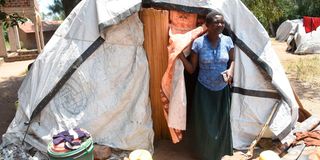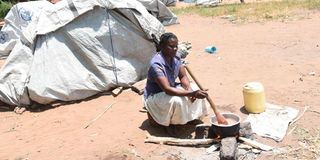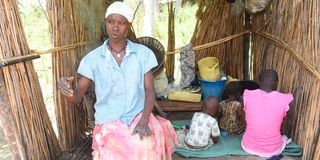
Women transport firewood in a boat at Runya, Budalang'i on August 31, 2023.
| Isaac Wale | Nation Media GroupBusia
Premium
Braving the elements: Resilience amidst Budalang’i's relentless floods
It is a hot, sunny day when I visit Budalang’i in Busia County; some semblance of normalcy has returned to the area, with children playing in the school grounds during their morning break while the rest of the villagers go about their daily business.
In Runyu, we first cross the Sigiri Bridge, a metal structure built over the Nzoia River. It takes us to Budala Primary School. From the children playing around, you would not know that this was once a camp for hundreds of villagers displaced by flooding caused by the receding waters of Lake Victoria.
As my team and I drive deeper into the villages, we come face to face with the aftermath of the devastation left behind. Parts of the land are still muddy, covered in knee-high bush and grass.
At Budala Primary School, a toilet has been slightly uprooted from the ground and hangs at a 60-degree angle. All round, several houses are abandoned, most of them permanent structures. Our journey takes us to Sidoho Bridge, a dilapidated, rickety, wooden structure that can only be crossed on foot or, for the brave, by boda boda.

Rosemary Auma outside her shelter at Rukala IDP camp in Bunyala, Busia County on August 31, 2023.
In parts of the bridge, the wood is completely rotten, so the villagers improvise by laying a single strip of wood to connect one point to the next.
To someone who has never been to Budalang’i, crossing the bridge might seem like a scene suited for the American TV show 1000 Ways to Die.
“Don’t look up, look down or you will die,” shouted one villager as he saw me struggling to cross the bridge.
My attention was drawn to a group of women rowing a boat towards the shore. They also noticed us but were askance, as if our presence was unusual.
On the boat they had a huge bundle of papyrus reeds. Christine Ajiambo says she and four other women get up at 4 every morning to go into the lake and harvest the reeds.
“I go out to collect so that I can earn some money to send my children to school. If I don’t, my children will sleep hungry and not go to school,” said Mrs Ajiambo.
Every day, four women set off in a boat to wade through the river, which is covered with lush papyrus reeds. Their mission is deep inside the river in search of dried papyrus reeds that they can sell to the villagers to use as firewood.
Of course, it is not without peril but bearable because at this time of day, poisonous snakes living among the reeds have not yet come out of their hiding places.

Edith Nafula Egesa preparing meal at Rukala camp in Budalangi Busia County on 31 August 2023. She was displaced from her home by floods in Budalangi in September 2019.
“It is still morning and the scorching sun is not very conducive to our work among the snake-infested reeds. The only time we can collect the reeds without encountering a snake is early morning before they come out to bask in the sun,” explains Ms Ajiambo.
It is a thankless chore since a bundle of papyrus firewood sells for between Sh50 and Sh100.
Runyu is one of the villages affected by the floods. The area used to be bustling with various economic activities from the lake and the rivers that flow into it.
The beach at Runyu used to serve not only as a recreational facility for the villagers but also as a place for fishermen to dock their boats after fishing, opening up the area to several fish markets.
However, the beach no longer exists as it is recently submerged. Although the water level has receded, most of the area has turned into a swamp.
“Nandele Beach no longer exists. Two villages that were also near the beach no longer exist. Since 2020, the villages remain under water,” said Godfrey Khamala, Bunyala’s flood relief coordinator.
“We have written to the government to come up with a permanent solution to this problem, but nothing much has been done. We are a forgotten people and live by the grace of God. Imagine all the people that have since 2019 been living in a tent,” Khamala said.
Things fall apart
Budalangi’s socio-economic activities are fishing and agriculture, but the floods have since destroyed most of the villagers’ fishing equipment.
The fishermen decided to pool resources and use the one fishing net they have left.

Some of the houses abandoned at Runyu village, Budalang'i in Busia County on August 31, 2023, due to floods.
“One hundred fishermen get together and lash together one huge net. Fifty of them hold the net on one side, and the other 50, the other as they trawl the water. The catch is shared among the hundred fishermen. We can no longer farm because the land is wholly waterlogged,” Mr Khamala adds.
Things started to fall apart for the people of Budalang’i in 2019, when the first backwater occurred. Some villagers abandoned their ancestral homes when they woke up to find their houses surrounded by water.
Mr Khamala vividly remembers the fateful day he lost his house. Unlike other natural water disasters that choose darkness, he says that this one happened at 10am.
When it happened, he and other villagers were at the dike trying to repair some of the places that the backwater had destroyed.
During this first backwater incident, the villagers started to monitor the water levels daily and when needed, they would raise the level of the dike.
It was a tedious task as each day they would fill sacks with sand to place on the dike, only to find the next day that the water had risen higher than expected.
Victorious Victoria
The tug-of-war between them and the water came to an end in April 2020, when Lake Victoria finally won the battle and burst over the dike.
“Two weeks before that happened, I started moving items out of my house when I saw that our efforts were not bearing fruit. I saw the warning signs that the water was giving us. Many other neighbours tried to ignore the reality,” he said.
As if the floods were not enough, the Covid-19 pandemic hit the country. The wrath of God had dealt us a blow using a double-edged sword.
But while the rest of the world saw the pandemic as a beast coming to rob them of their livelihoods, Covid proved to be a blessing in disguise for the people of Budalang’i.

Josephine Adhiambo making dresses outside her shack at Khukunda camp in Budalang'i on August 31, 2023.
“The pandemic forced the closure of all educational institutions, thereby lending our displaced people a place to set up temporary camps. In total, 18,224 families were displaced by the floods.”
“Initially, there was no rescue centre we fled to but when the government ordered the schools to close, everyone sought shelter there since most schools are built on higher ground,” he said.
A total of 64 camps have been set up in Budalang’i. In the early stages, before any government or foreign aid arrived, only to find all locals crammed into classrooms.
The first villages to be affected were Runyu, Osieko, Maduwa, Bukhuma, Iyanga, Rukhala and Amavinje in Bunyala South and Lunyofu, Siginga and Bukoma in Bunyala West. Bunyala East and Central were spared.
According to Mr Khamala, close to 30 villages were completely submerged and no longer exist.
“The problem of flooding has been a plague for Budalang’i since the 1960s. In the 2020 floods, four villages (Mukhuwa, Sitome, Bukhunja and Mudimbya) were submerged. In the Yala swamp, out of a total of 52 villages, 22 disappeared under water for good,” said Mr Khamala.
My tent My castle
Three years on, with the reopening of schools following the containment of Covid-19, most of the IDPs who lost their homes have struggled to find alternative shelter.
And many of those affected continue to live in squalid conditions. Evelyne Nabwire, a mother of six, is one of the people who found a piece of land to pitch the 10 x 10-foot tent she calls home.
It is midday and I find her sitting in the shade of a tree with her three children, eating a stick of sugar cane she harvested from her small farm. It is her first meal of the day.
Although the water has receded in some areas, the ground is still too muddy to build anything. Apart from the lack of basic needs such as food, shelter and clothing, sanitation is also a problem. When they try to dig pit latrines, their efforts are thwarted when they find water after digging just one metre.
Nabwire’s husband is a fisherman and she used to sell fish, but now she stays home and cultivates the land because the amount of fish from the lake has decreased.
The tent she calls home is held up by four posts and held down by huge stones on the floor. At night, when it gets windy, they live in fear of the tent being uprooted as it is lashed by the strong winds.
For Nabwire, James Halliwell-Phillipps’ famous fairy tale “The Three Little Pigs” is closer to reality, only for her, the big bad wolf threatening to blow her house away is nature itself.
Signs of rain are a blessing for most people, but for Nabwire, rain means spending the night standing in a corner that is not leaking and placing basins and other containers to collect the water that leaks through many parts of the tent.
“I lost everything to the floods. All I have now is from the generosity of well-wishers. We were evicted from the schools where we had sheltered but had no homesteads to return to since it was still under water. We decided to pitch our tent on my husband’s family land, which was also badly affected, and soggy since some water had reached it,” said Mrs Nabwire.
The sound of the strong winds is not the only thing to worry about. Sleeping in the tent is literally like sleeping in the open air. At night, when you light a lamp, people outside can see inside through the shadows you cast as well as the household items inside. Occasionally a wild or stray animal’s cry can be heard by Nabwire and her children. Her husband is away most of the time with other fishermen.

Everlyne Nabwire and her children at Mutongwe village in Budalang'i on August 31, 2023.
“I can no longer afford to take my children to school. My third born started primary one this year with donations from my fellow churchgoers. She was able to sit in class for the first term. But she is now back home after being chased away for school fees arrears. Only God knows how I will survive. Life is really hard,” said Nabwire, blinking away the inevitable tears.
To make ends meet, she sells some of the vegetables she grows outside her house, which on a good day earns her a maximum of Sh200. They hope that someday, their misery will end.
Edith Nabungu reads from the same script as Ms Nabwire. She and her family had taken shelter in the compound of the only dispensary serving the people of Bunyala. When things returned to normal, they were evicted and now camp outside the dispensary.
At 2pm, Ms Nabungu is stirring porridge, which will be her family’s evening meal. Their house in Rukhala - one of the affected areas - was completely destroyed by the floods.
Today, they sleep on the floor of a tent, which they leave at 7am and return to at night. This is because of the unbearable heat inside the tent during daytime.
“We do not know what to do to find money to rebuild our houses and pay school fees,” said Nabungu.
For toilet and bathroom breaks, they rely on the charity of neighbours whose homes were not affected.
“For the past five years, I have begged to use the toilet and bathroom in other peoples’ houses. Will my family ever get out of this situation?” Ms Nabungu poses.
Budalang’i has experienced at least five major floods since 1942. The floods are caused by a combination of factors, including heavy rainfall, water backing up from Lake Victoria, siltation of rivers that feed the lake, and poor maintenance of dams and embankments.
The floods have caused widespread destruction of homes, crops, infrastructure and livelihoods, as well as posing health and environmental risks.
Some of the worst floods in Budalang’i occurred in 1961 when more than 100 people died and 30,000 were displaced. In 1997, 34 people died and 150,000 were displaced. The most recent is 2020, when more than 40,000 people were displaced.





